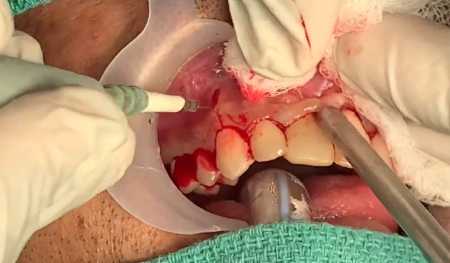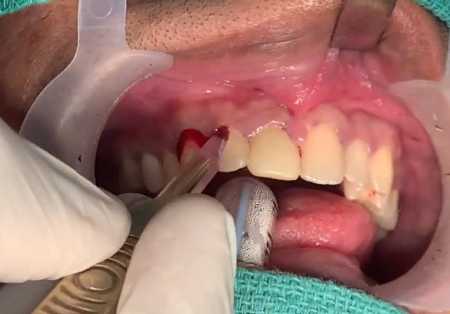What types of tooth and jaw cysts exist, their symptoms, and treatment options are all covered in our article. In addition, you will learn how much the surgery to remove a tooth cyst costs.
A dental cyst is a pathological neoplasm that occurs as a result of the body’s defensive reaction to an infection or trauma. A cyst occurs when pathogens that cause inflammation enter the jawbone tissue through the root canal. Gradually, the cells involved in the disease process die, forming a cavity in the bone tissue. To prevent the process from spreading, our body forms a capsule with dense walls around the necrotic area.
What Is Tooth Cyst
The resulting neoplasm contains inflammatory fluid, dead cells, decay products and bacteria. Size ranges from a few millimeters to several centimeters. Small ones (less than 5 mm in diameter) are called granulomas. Granulomas, cystogranulomas, and cysts are stages of an inflammatory process in the bone tissue of the jaw. As long as it is small, there are no manifestations. The number of germs in it continues to grow, but because it occurs under the control of the immune system, the process develops unnoticed. Through the blood vessels that feed the bone tissue, immune cells are sent to the cyst. This is how the body tries to cope with the problem. But if the immune system weakens, the disease goes into an acute phase.
Causes of Tooth Cyst Development
The development of the disease can lead to severe consequences. The increase in size threatens to fracture the (especially lower) jaw, the loss of teeth involved in the inflammatory process, the transformation into a malignant tumor. The aggravation of the disease leads to the development of periostitis, purulent abscesses, or even osteomyelitis. If even at this stage the patient does not receive qualified medical care, sepsis can occur. This is an extremely serious condition characterized by the infection entering the bloodstream and then spreading throughout the body.
The causes of
- Untreated complicated caries;
- Improper treatment of root canals (read also Toothache After a Root Canal Cleaning);
- trauma;
- Improper prosthetics, leading to the overloading of individual teeth;
- Abnormal development of the upper or lower jaw;
- Infectious diseases of the oral cavity and nasopharynx.
Regardless of the cause of the cyst, treatment should be entrusted to dentists to prevent complications.
Types of Cysts
Root cyst
Develops from a granuloma as an extension of pulp necrosis (pulp tissue death) and as a result of periapical inflammation. It is located in the apical (apical) third of the tooth root and sometimes has a transverse orientation due to additional canals, the original pathways of pulposal necrosis.
Root cysts are X-ray-transparent capsules with well-defined borders. They can vary greatly in size from 2-3 mm to 2-3 cm. In the absence of secondary inflammation, root cysts develop asymptomatically. Even the largest neoplasms do not displace teeth or expand bone tissue.
Once diagnosed, treatment requires elimination of the underlying cause. Most often, endodontic treatment of pulp necrosis is performed. If it is not successful, the decision is made for surgical curettage or enucleation.
Residual
Remains after removal of the pathology. It can form in the granuloma left after the tooth extraction or around the remaining root tip.
Residual cyst is well-defined on x-rays. Its size ranges from a few millimeters to several centimeters.
Follicular cyst on the gum
A cyst in the gum develops from a follicular pouch encompassing each uncut tooth. It is a capsule, clearly visible on x-rays, most often surrounding the crown of an erupted tooth. It can cause extensive damage to the tooth. It grows rapidly, can move onto adjacent teeth, and can cause enlargement of the cortical plate.
Clinically, a follicular cyst always occurs in the area where the enamel meets the tooth cementum (the place where the follicle is attached). Due to its growth, the adjacent teeth may tilt, and in rare cases there is resorption (destruction) of the tooth roots. Teeth that have not erupted may also shift because of aggressive growth. If a follicular neoplasm has been identified, treatment for it may involve surgical curettage (scraping).
A teething cyst
This is a fluid-filled follicular sac that usually occurs during teething. It covers an erupting tooth and often contains blood. Externally, it looks like a pronounced swelling of soft tissue of a bluish color (due to the presence of blood). It occurs most often due to the slow eruption of the tooth and may rupture spontaneously. However, in some cases when it is found, treatment may involve surgical resection to help the tooth erupt more quickly.
Primordial (keratocyst)
Develops from a dental embryo as a result of degeneration of the stellate reticulum during tooth development before the calcification of the tooth tissue begins. Keratocysts can arise from any developing dental rudiment, but most often they are localized in the area of premolars and third molars of the lower jaw.
Symptoms of Dental Cysts
Most often formed as a result of traumatic injury or infection, such as poor-quality root canal filling in the sinus of the tooth. Often this pathology occurs on the background of frequent sinusitis. Its treatment should begin with a visit to the dentist and an X-ray. In the early stage, it does not manifest itself in any way. The primary symptom is discomfort when chewing solid food.
As the disease progresses, protrusion of bone tissue or a fistula on the gum in the area of the apex of the damaged tooth may be observed.
When the condition worsens, patients complain of sharp pain. The cause of the transition to an acute phase can be a weakened immune system, relapse of chronic diseases, cold, infectious diseases, taking certain medications, such as immunosuppressants (drugs that artificially suppress the immune system). An exacerbation may be accompanied by the following symptoms:
- Swelling of the face in the area of the affected area;
- increase in body temperature;
- general malaise;
- increase in size and painfulness of submandibular cervical lymph nodes;
- pain in the area of the damaged tooth, intensifying with chewing.
You should not ignore these symptoms if you want to carry out treatment without removing the tooth. At the first signs of the disease, you should immediately seek help from your dentist.
Treatment of Cysts Without Tooth Extraction
The success of treatment directly depends on how early it was detected. Therefore, dentists recommend that patients regularly undergo preventive examinations and seek help at the first signs of the disease. Quite recently, therapy necessarily involved the extraction of a tooth. Of course, this approach did not suit either doctors or especially their patients. Today, dentists’ methods have changed considerably, and it is possible to get rid of the cyst without losing the beauty of your smile.
Cyst treatment can be surgical or conservative. The choice of therapy method depends on: type, age of the patient, personal wishes and is determined for each patient.
Surgical Treatment
Most often, a cystectomy procedure is performed to surgically remove the neoplasm. It involves the removal of the cyst and the damaged apex of the root. The advantage of this method is high efficiency. Its disadvantages include the fact that cystectomy is a fairly complex operation, and not every surgeon decides to perform it.

A more complicated method is hemisection. This operation is performed when one of the roots is completely destroyed. During surgery, the doctor removes the disease capsule, the damaged root and part of the crown of the tooth. The defect resulting from the surgical resection is repaired with composite materials or a crown.
Much depends on the stage at which the capsule was discovered. Treatment can be accompanied by removal of the tooth only if it is entirely in the cyst capsule or if its tissues are almost completely destroyed.
Conservative Treatment
This type of therapy allows a cure without surgical intervention. In this case, no incision is required to gain access to the neoplasm. At the initial stage of treatment, the dentist drills and cleans the affected root canal. The top of the root of the tooth connects to the cyst, so once the root canal is opened, the contents flow out. After cleaning and disinfecting the root canal, the doctor injects antibiotics and substances into the cavity to destroy its capsule.
After that, the doctor fills the resulting cavity with a special paste, which will help restore bone tissue. Then the hole is sealed. If after 6 months the cyst is not detected on x-rays, treatment can be considered successful. This method helps in about 75% of cases.
An innovative method of treatment without surgery is deprophoresis. It helps eliminate infection in all root canals without drilling them. The dentist exposes the root canal mouth and inserts an electrode into the root canal. Another electrode is pressed against the surface of the cheek, and a weak current is given. Together with the discharge through the root canal passes copper-calcium hydroxide, which penetrates to all the hard-to-reach areas, destroys all the bacteria, microorganisms and dead cells.
After three sessions of dephosphoresis, the damaged tooth is filled and its crown is restored. Regardless of what type of neoplasm was found, dephosphoresis treatment can get rid of it almost 100% of the time.
Cost of Dental Cyst Removal
If we are talking about removing the cyst together with the tooth, then the cost of the operation corresponds to the cost of removing the tooth. The cyst, as an outgrowth on the root of the tooth, will be removed along with the tooth and it will not require additional procedures.
What’s the average cost to have a tooth pulled? The average cost to have tooth extracted is dependent on whether your tooth is affected or not. To have an easy tooth extraction, you will get charged an average of $75 to $200 for each tooth. The kind of anesthesia used will likewise identify the tooth extraction cost.
If the tooth is impacted, the average cost of tooth extraction in USA is around $800 to $4,000 in 2025. Your house place might likewise affect the amount you pay for teeth removal since services get personalized according to a specific region’s living cost.





